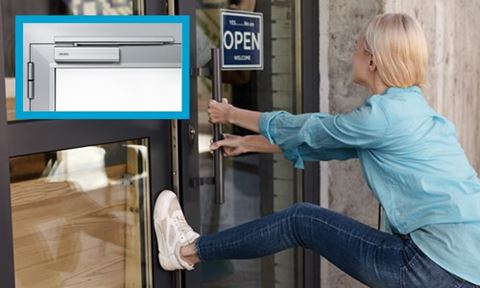Installing the right access control system for a property — for access through an entrance or interior door — can be the difference between making buildings accessible or simply swapping one barrier for another.
Many countries and international organisations including the European Union suggest or enforce accessibility standards for public and private buildings. In many cases, according to Assa Abloy these regulations apply for specifying both new construction and retrofit projects.
Installing a door closer is often seen as an ideal solution. The right door closer will ease access through heavy or otherwise awkward openings.
When every important door opens with less effort, building owners offer a more equal experience and encourage participation in the workplace or public life. However, not every door closer will do this job well enough.
Factors to consider when choosing the right door closer
Architects, specification teams, security managers and builders consider many factors before choosing a door closer. From an accessibility point of view, Ass Abloy recommends that the following four can serve as a useful checklist for improving the inclusiveness of a design:
1. Opening force: for genuinely barrier-free accessibility, the force required to open the door should be as low as possible
2. Closing force: the door should close fully and automatically, for user convenience, energy efficiency, building security and to comply with fire protection rules
3. Closing delay: the final closing section can be a danger point for finger trapping, too quick closing which obstructs users, or damage which could impact performance, so a door closer should be able to adapt to maintain accessibility
4. Flexibility: no two doors or buildings are the same, so the door closer should allow variation where feasible in any of the above
Often overlooked, aesthetics is another important consideration. A modern door closer must be discreet, with a contemporary design that blends into its surroundings. It should not make the building look like an “institution”.
Cam-Motion technology for barrier-free access
Door Closers with Assa Abloy’s Cam-Motion technology provide ergonomic opening for everyone who passes through them. Unlike traditional rack-and-pinion door closers, Cam-Motion Door Closers with guiderails require a push-force that falls rapidly. Cam-Motion mirrors the power of a human elbow, where torque also reduces sharply as the arm extends. This translates into much easier opening and greater comfort.
Assa Abloy Door Closers offer optional closing delay, which allows extra time for any user to pass through the door. To protect the frame and prevent banging into walls, the back-check function as standard across the range slows the door’s final opening section before shutting tight. They are tested to meet EN 1154 standard for fire and smoke protection and fulfil barrier-free building requirements.
Cam-Motion Door Closers maximize flexibility without impacting their accessibility benefits. Their design allows fitting to either frame or door, and on hinge or non-hinge side, so the user can select whatever suits the opening best. They can equip both single- and double-leaf doors.
Cam-Motion technology is designed with independent valves, enabling separate latch and closing speeds to be set, so closing performance meets the door’s specific use. These valves are thermo-resistant: Once door speeds are set, they stay set — even at extreme temperatures.
“In meeting all these important accessibility criteria, Cam-Motion Door Closers do not sacrifice any durability,” says Andreas Gmelin, Product Management and Business Development Director, EMEIA Door Closer Product Unit at Assa Abloy Opening Solutions. “Door Closers are often deployed at a building’s busiest doors. They need to be tough.”
Source: SECURITYWORLDMARKET


